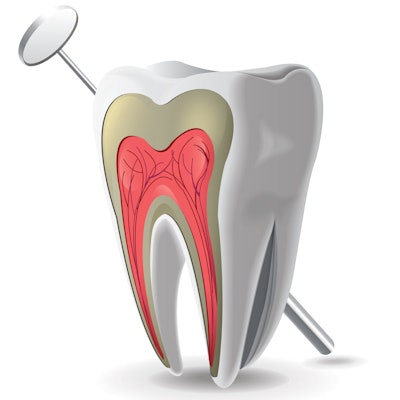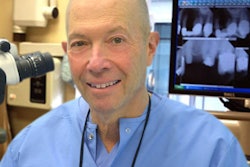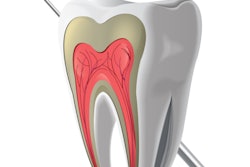
Clinicians preserved a patient's split tooth using a nonsurgical technique that included widening and sealing the fracture gap with mineral trioxide aggregate (MTA) and composite, according to a case report published online on May 3 in the Journal of Endodontics.
Three years of follow-up showed the successful treatment of the patient's first maxillary premolar, which had a fracture in the mesiodistal direction, the authors wrote in the case report/clinical technique article.
"Here is an alternative treatment option for a split tooth, which allows preservation of the tooth rather than its extraction," noted the group, led by Alexander Schürz, DMD, of the department of conservative dentistry at University Hospital Heidelberg in Germany.
Treatment without surgery
When a tooth contains a fracture line extending from the occlusal surface through both marginal ridges, it is considered a split tooth. Currently, the only treatment option for a split tooth is to extract it or remove part of the mobile segments. The new approach used on a 48-year-old man who experienced latent pain in his tooth was offered as a way to preserve the tooth without surgery.
His tooth was sensitive, and it had not undergone any prior restorative treatments. Pulp testing elicited an immediate but prolonged reaction, and periodontal probing showed an isolated defect of 11 mm. A fracture gap running in the mesiodistal direction was seen in the central fissure area of the occlusal surface. Otherwise, he had a healthy mouth, according to the authors.
Treatment phases
After learning about possible treatment options, the man opted for nonsurgical treatment, which occurred in the following phases:
- Primary fracture treatment. Clinicians widened the fracture gap using a dental operating microscope and obturated the apical part of the root canals with an MTA plug. The fracture gap was sealed with MTA, a biocompatible material. (If the inflammation of the periodontal tissue surrounding the fracture gap does not allow immediate repair of the fracture because of profuse bleeding, then calcium hydroxide should be applied to the gap and root canal system, the authors noted.) Occlusal adjustments were then made.
- Secondary fracture repair and internal stabilization of the tooth. This session occurred within 48 hours of the first. During the visit, the MTA layer was reduced to minimum thickness to allow for the dry application of composite resin, then the cement and remaining fracture gap was covered immediately with composite resin. A layered application of composite resin was completed to fill the root canal system for internal stabilization and complete reconstruction, they wrote.
- Coronal treatment with indirect cuspal coverage restoration. On the third visit, his tooth was prepared for the restoration. Then, on the final visit, adhesive cementation of a lithium disilicate restoration with dual-curing composite resin was completed. The patient also was given oral hygiene training, including the routine use of interdental brushes.
The patient returned for follow-up visits every six months for three years. Clinical and radiological exams showed that the treatment corrected the problem. Part of the success of this treatment must be attributed to the patient maintaining good oral hygiene, the authors noted.
Furthermore, split upper premolars are best suited for this treatment procedure. Lower molars with a fracture line through the furcation also may be suitable. However, teeth with lengthwise fractures may be better treated by surgery with resection of the fractured root or extraoral fracture repair followed by intentional replantation, they warned.
Nevertheless, additional studies are needed to confirm the long-term feasibility and success rates of this new approach. Once more clinical studies are completed, this method may be recommended for general use, the authors wrote.
"The method of restoring split teeth with MTA and composite is a treatment option worth considering," they wrote.




















